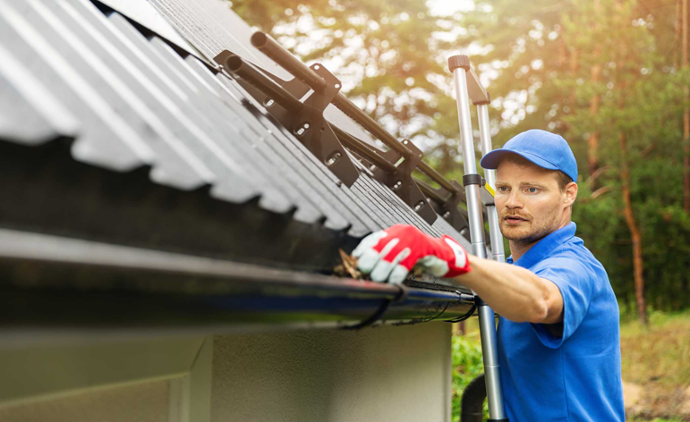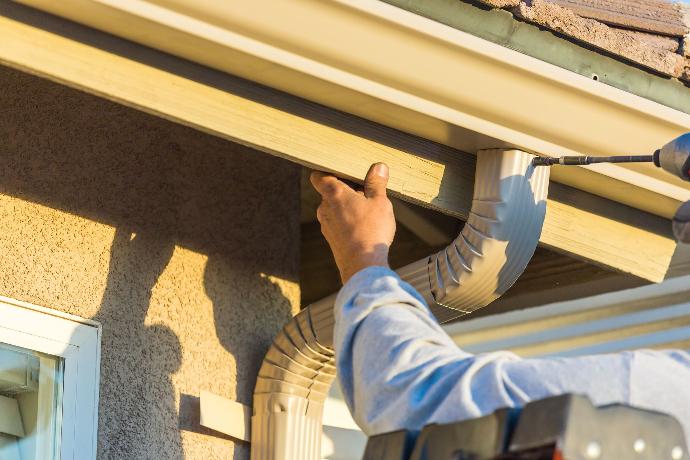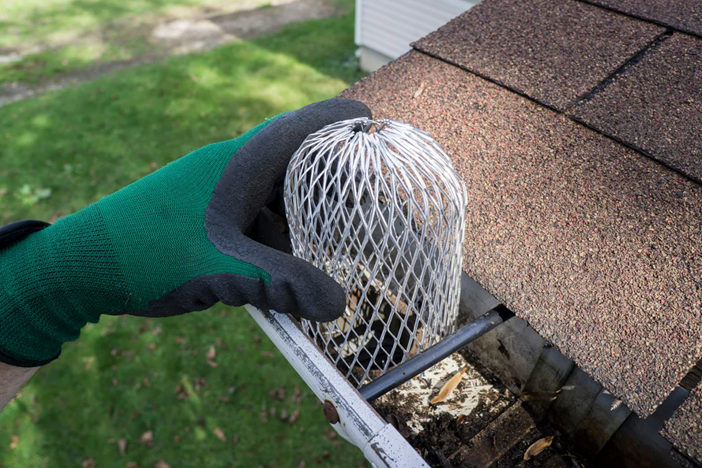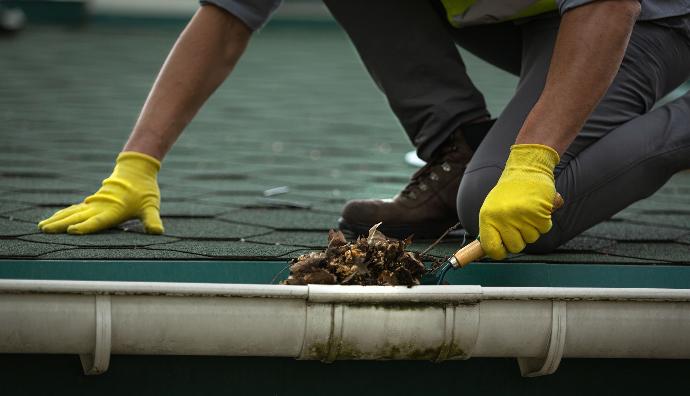How do you clean downspouts?
Cleaning downspouts is probably the hardest part of gutter cleaning. If a gutter cleaning has been completed and the gutter is continuing to overflow during rainstorms, then it is very likely that there is an internal clog inside of the downspout itself. Clogged downspouts are not the only cause for overflowing gutters but it is a very common cause. Clogs or obstructions inside of the downspout are usually located at one of the top elbow joints rather than the straight vertical pipe. Here is a guide on how to diagnose and clean a downspout:
To perform this task, you will need a stable extension ladder, gloves, roofing prybar, cordless drill w/ ¼” inch driver, biodegradable BB’s, leaf blower, garden hose, and a trash bag or bucket. Remember that cleaning gutters is a dangerous task and should only be performed by individuals who are experienced and comfortable working on top of tall ladders.
How do you clean downspouts step by step?

Ladder Setup
Set the ladder up in a stable position next to the downspout location. The top of the ladder should be extended above the height of the downspout so that you can look down at the gutter outlet and inspect the inside of the top downspout elbows.
Visual Check
After clearing the debris from inside of the gutter, visually check the inside of the top downspout elbows to see if any debris can be seen. Remove any downspout covers or downspout strainers if they are present. If debris is not visible, drop a few of the biodegradable BBs down the pipe and listen to hear how far they go down the pipe before they stop. This can be repeated to re-confirm how far down the pipe they make it until they stop at the internal clog. This strategy can be used to determine at what point the downspout is clogged internally. If the BB’s make it all the way through the downspout without obstruction, then it can be determined that there is not a clog inside of the downspout. If debris are visible, using gloves, grab any accessible debris out from inside of the top downspout elbow. You can also use the roofing prybar to loosen the leaves and/or scoop the leaves out from the top.
Blow Air
Using a leaf blower, point the blower downwards in line with the downspout elbows and blow air through the downspout in case there are any loose leaves that could be slowing down the flow of water through the downspout. Keep an eye out for any debris that may be blown out through the bottom elbow near the ground as this could indicate that the clog has been dislodged and removed. If you see steady air blowing out of the bottom downspout elbow near the ground, you can turn off the blower and continue to the next step.
Remove Downspout Elbows
If the downspout elbows are clogged and the blower or hose did not dislodge the debris, then you may need to remove the downspout elbows entirely to remove the debris. Using the cordless drill, unscrew all the ¼” zip screws from the elbows and put them into your pocket for re-installation. Remove the screws from the straps that are securing the top of the vertical downspout pipe to the wall as this will make it easier to pull the downspout elbows off. Pull the top elbow down and outwards to remove it from the gutter outlet sleeve.
Once it is free, pull both elbows upwards to free them from the vertical downspout pipe. Once the elbows are completely separated you can usually shake the elbows and the debris will drop out. A prybar can also be used to dislodge the debris if they don’t shake out of the elbows. After the debris has been removed the downspout elbows can be re-installed starting by tucking the lower elbow back inside of the vertical downspout pipe. Then press upwards on the gutter gently so that the upper elbow can slide back onto the gutter outlet sleeve. Once all the pieces are re-assembled the screws can be re-applied back into all the existing holes.
Flush Again
Re-confirm that all the clogs have been removed by running water through the downspout. Once you have verified that the water is no longer being obstructed the downspout cap or downspout strainer can be put back into place.
Additional Tips
Cleaning gutters more regularly will reduce the chances of downspouts becoming clogged. Gutter Guards are also a great solution to clogged downspouts. Gutter Guards will not eliminate the need for gutter cleaning entirely as debris will often accumulate on top of the gutter guards, however they do a fantastic job at preventing downspouts from clogging internally because they filter out all the larger debris that are typically responsible for the internal downspout clogs.
Remember if you’re not experienced or comfortable working on top of tall extension ladders then gutter cleaning and downspout cleaning is a task better left to a professional gutter cleaning service. Ideally one that includes a guarantee with their gutter cleaning service such as Golden Hammer Gutters with their 60-Day No-Clog Guarantee.


